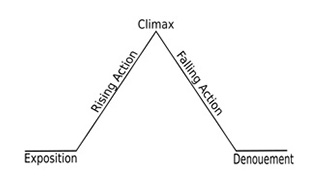Producing a consistent and effective plot
 There are many names for a plot outline; one of our favorites is the plot skeleton. Some people also call it "the universal plot," while others simply call it "basic structure." Whatever you refer to it as, the plot outline is what will hold up your story if you know how to use it—or cause it to collapse if you don't.
There are many names for a plot outline; one of our favorites is the plot skeleton. Some people also call it "the universal plot," while others simply call it "basic structure." Whatever you refer to it as, the plot outline is what will hold up your story if you know how to use it—or cause it to collapse if you don't.
Many people, when they learn what a plot outline is, fail to see the point of it. Why, they ask, would they want to use a format that is found in every other story known to humankind—where is the creativity in that? the sense of art? The answer is simple: it works. There's a reason why every story that touches your emotions sounds familiar when you strip it down to its bare bones.
The plot outline at its simplest
The following is an example of a plot skeleton:
You start out with a character—let's call him Character X. This character finds himself in some kind of trouble and does his best to get out of it. However, everything Character X does only seems to make the trouble worse.
Just when it seems Character X has come to the very lowest point imaginable, he manages to work out the issues through some kind of insight or ingenuity, and all is right in the world.
Every story needs this plot resolution in order for your readers to feel like their time was well spent on your novel.
We challenge you to find a truly great story that doesn't follow this plot structure to a certain degree—you'll find that it's extremely hard. While we're sure there are a few out there, it's virtually impossible to think of a single one offhand.
It is a human instinct to identify with a sympathetic character. Through struggle, readers form an emotive bond with the character, and the suspense surrounding the character's uncertain fate keeps them interested. If you are not giving your reader any kind of struggle and there is no suspense created by Character X moving through various roadblocks toward some kind of goal (the eradication of that struggle), your readers will not connect with your character and won't care what happens to him.
To put it bluntly, they will toss your novel aside and turn their attention to something that better provides what they're looking for.
Remember, a plot skeleton is only bones…
Many writers forget that a skeleton is just that—bare bones. Humans all have skeletons that look pretty much alike, but we all look vastly different when flesh, hair, and snazzy clothes cover them up.
The plot outline is not the be-all and end-all of your plot; it's just the scaffolding holding up the walls of your construction. The complication that sends your character into distress does not have to be huge; your main character doesn't have to be charged with recovering stolen nuclear weapons or with the task of taking a magic ring to Mount Doom to save all of humanity.
Your character might be a sweet but socially challenged man, who, in the search for his sweetheart, bungles through all kinds of schemes to meet women before discovering that his next-door neighbor was the woman of his dreams all along.
Your character might be a teenage girl, desperately trying to find herself, who dyes her hair electric blue, gets a belly ring, or takes up cheerleading to boost her popularity only to find that all she needed was one true friend.
All of these stories follow the plot outline archetype previously described, yet each is dramatically different, and each has a good plot.
The possibilities are endless. You are not limited to any specific genre—the plot outline is truly universal. Your hopeless young man could live in China, India, or Milwaukee, and the story could be set in the present, the 1930s, or 300 years into the future.
Ultimately, it is up to the author to wrap his or her plot skeleton in muscle, sinew, and skin, placing within it the heart that will make a unique and beautiful literary creation.
And remember, if you need a book critique, let our editors take a look!
Image source: Matthew MacQuarrie/Unsplash.com











